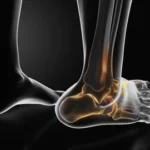An ankle sprain is one of the most common injuries seen by any ankle doctor, yet knowing when to worry about sprained ankle pain can make the difference between quick recovery and long-term issues like chronic instability. A sprain occurs when the ligaments, the tough bands connecting bones in the anatomy of the foot and …
An ankle sprain is one of the most common injuries seen by any ankle doctor, yet knowing when to worry about sprained ankle pain can make the difference between quick recovery and long-term issues like chronic instability. A sprain occurs when the ligaments, the tough bands connecting bones in the anatomy of the foot and ankle, are stretched or torn, usually after a sudden twist, roll, or awkward landing. While some sprains are minor and respond well to at-home treatment, others may involve ligament damage, tendon injury, or even an ankle fracture, requiring prompt care from a foot and ankle doctor near you.
Quick check: Is it a sprain – or something more serious?
Before you can treat the problem, you need to know if you’re dealing with a torn or twisted ligament from an ankle sprain or a broken ankle that demands urgent attention. Understanding the early signs and differences can prevent complications such as chronic ankle sprains, instability in the ankle joint, or persistent pain. Many patients wait too long to get a proper diagnosis and tests, which can lead to delayed healing.
Roughly nine out of ten ankle sprains happen when the foot rolls inward, a motion known as an inversion injury. This type of movement typically injures the anterior talofibular ligament (ATFL) and the calcaneofibular ligament (CFL), which are the lateral ligaments found on the outside of the ankle.
Understanding whether your injury is a sprain or fracture early on helps ensure you get the right level of care.
Classic sprain symptoms vs. fracture signs
- Sprain: Localized pain over ligaments, swelling, stiffness, and mild to moderate bruising. You may still be able to walk with a limp, but difficulty walking and tenderness to the touch are common.
If you’ve taken a fall or twisted your ankle and are experiencing pain, noticeable swelling, sprained ankle bruising, and difficulty walking, there’s a good chance you have an ankle sprain. It’s important to see a healthcare professional or ankle doctor promptly so they can evaluate the injury, confirm the diagnosis, and provide a personalized treatment plan. - Fracture: Pain directly over a bone, visible deformity, or an inability to bear weight even for a few steps. An untreated fracture can cause long-term instability and improper bone healing.
Read our blog for a full breakdown of the types of ankle sprains.
Red flags that mean “see a doctor now”
If you have severe pain, significant swelling, an audible popping or cracking noise, numbness in the foot or toes, or an open wound, it’s when to worry about sprained ankle symptoms. Worsening pain after 48–72 hours or signs of infection, such as redness, warmth, or pus, also require urgent evaluation. These symptoms may point to ligament damage, peroneal tendon tears, or posterior tibial tendon injury.
An ankle sprain is one of the most common injuries seen by any ankle doctor, yet knowing when to worry about sprained ankle pain can make the difference between quick recovery and long-term issues like chronic instability. A sprain occurs when the ligaments, the tough bands connecting bones in the anatomy of the foot and ankle, are stretched or torn, usually after a sudden twist, roll, or awkward landing. While some sprains are minor and respond well to at-home treatment, others may involve ligament damage, tendon injury, or even an ankle fracture, requiring prompt care from a foot and ankle doctor near you.
Quick check: Is it a sprain – or something more serious?
Before you can treat the problem, you need to know if you’re dealing with a torn or twisted ligament from an ankle sprain or a broken ankle that demands urgent attention. Understanding the early signs and differences can prevent complications such as chronic ankle sprains, instability in the ankle joint, or persistent pain. Many patients wait too long to get a proper diagnosis and tests, which can lead to delayed healing.
Roughly nine out of ten ankle sprains happen when the foot rolls inward, a motion known as an inversion injury. This type of movement typically injures the anterior talofibular ligament (ATFL) and the calcaneofibular ligament (CFL), which are the lateral ligaments found on the outside of the ankle.
Understanding whether your injury is a sprain or fracture early on helps ensure you get the right level of care.
Classic sprain symptoms vs. fracture signs
- Sprain: Localized pain over ligaments, swelling, stiffness, and mild to moderate bruising. You may still be able to walk with a limp, but difficulty walking and tenderness to the touch are common.
If you’ve taken a fall or twisted your ankle and are experiencing pain, noticeable swelling, sprained ankle bruising, and difficulty walking, there’s a good chance you have an ankle sprain. It’s important to see a healthcare professional or ankle doctor promptly so they can evaluate the injury, confirm the diagnosis, and provide a personalized treatment plan. - Fracture: Pain directly over a bone, visible deformity, or an inability to bear weight even for a few steps. An untreated fracture can cause long-term instability and improper bone healing.
Read our blog for a full breakdown of the types of ankle sprains.
Red flags that mean “see a doctor now”
If you have severe pain, significant swelling, an audible popping or cracking noise, numbness in the foot or toes, or an open wound, it’s when to worry about sprained ankle symptoms. Worsening pain after 48–72 hours or signs of infection, such as redness, warmth, or pus, also require urgent evaluation. These symptoms may point to ligament damage, peroneal tendon tears, or posterior tibial tendon injury.
Sprained ankle bruising: what the colors and timing tell you
Sprained ankle bruising is one of the most visible signs after injury, and understanding what it means helps guide recovery decisions. Bruising results from tiny blood vessels breaking under the skin due to ligament or muscle strain damage. The color and pattern can indicate the severity of the injury and whether to keep monitoring at home or see an ankle doctor.
Bruise color stages (red/purple → green/yellow) & typical timeline
Initially, bruises appear red or purple due to fresh bleeding under the skin. Over several days, the color changes to green or yellow as the body reabsorbs the blood. While mild bruising can be part of normal healing, widespread bruising may mean more severe ligament healing is required.
When bruising suggests a more serious injury
Bruising that spreads to the foot or toes, combined with tense swelling or blistering, should raise concern. This can indicate severe ligament damage, an overstretched or torn muscle, or even a hidden fracture. These signs are when to worry about sprained ankle recovery and seek ankle sprain treatment in Brookfield, Wisconsin.
When to see an ankle doctor (and when urgent care/ER is best)
Knowing when to worry about sprained ankle pain and swelling is key to avoiding long-term problems like ankle instability or repeat ankle sprains. A timely visit to an ankle doctor ensures accurate diagnosis and tests such as x-ray or MRI scans.
See a podiatrist/sports medicine doctor within 24–48 hours
If symptoms do not improve after two days of PRICE therapy (Protection, Rest, Ice, Compression, Elevation), book with a podiatrist or foot and ankle doctor near you. Early intervention can prevent chronic instability and speed recovery.
Go to urgent care/ER for severe cases
Head to urgent care or the ER if you experience severe pain, deformity, or an inability to bear weight. Untreated ankle fractures or severe sprains can require immobilization with a splint, ankle brace, or even an immobilized cast.
What to do at home in the first 48 hours
Starting the right at-home treatment immediately after injury is critical. This early stage is when to worry about sprained ankle worsening if swelling and bruising are left unchecked. Proper care reduces the risk of chronic instability.
PRICE/RICE done right
Follow the PRICE method:
- Protection: Limit motion using an ankle support or brace.
- Rest: Avoid activities that cause pain to allow ligament healing.
- Ice: Apply a cold pack or ice pack for 15–20 minutes every 2–3 hours.
- Compression: Use an elastic bandage to control swelling without cutting circulation.
- Elevation: Keep your ankle above heart level to aid swelling reduction.
Over-the-counter pain relief
Anti-inflammatory drugs like ibuprofen and over-the-counter pain medications can ease discomfort and swelling. Always use as directed and confirm with your healthcare provider.
What to expect at your visit
An ankle doctor will perform a full physical exam and may order x-rays or MRI scans. This helps identify whether you have a mild sprain, high ankle sprain, tendon injury, or ankle fracture.
Grading the sprain
- Grade 1: Minor stretch injury with mild pain and swelling.
- Grade 2: Partial tear of a ligament requiring more structured care.
- Grade 3: Complete tear or severe ligament damage that may need immobilization or surgery.
High ankle sprain vs. typical sprain
A high ankle sprain affects the ligaments connecting the tibia and fibula, leading to slower healing. Recognizing the difference is important when to worry about sprained ankle recovery delays.
Treatment by severity
Treatment plans depend on the sprain grade, overall health, and activity level.
- Grade 1: Early gentle movement, range-of-motion exercises, and light balance training can restore function in 2–3 weeks.
- Grade 2: Often requires an ankle brace or boot, plus rehabilitation exercises and muscle strengthening over 3–6+ weeks.
- Grade 3: May need casting, longer rehab, and in rare cases surgery for chronic instability or ligament damage.
Getting back to activity – without repeat sprains
Rehab doesn’t end when pain stops. Preventing repeat ankle sprains means continuing strength training, stretching, agility exercises, and proprioception drills. Wearing supportive footwear and practicing surface awareness can prevent trips and falls.
Local care: foot & ankle doctor near me in Brookfield, WI
When you need an ankle doctor you can trust, the Wisconsin Foot & Ankle Clinic offers personalized care from initial diagnosis and tests to full rehabilitation. They provide same-week appointments for ankle sprain treatment in Brookfield, Wisconsin.
Conclusion
Now you know when to worry about sprained ankle pain and sprained ankle bruising changes. Early care, accurate diagnosis, and targeted rehab protect your ligaments and get you back to activity faster. For local expertise, contact the Wisconsin Foot & Ankle Clinic today.
FAQs
How do I know if my ankle sprain is serious?
If you have severe pain, inability to bear weight, or a visible deformity, seek urgent care.
How do I know if my sprained ankle is healing properly?
Improvement in pain, swelling, and mobility within days is a good sign. Stalled recovery is when to worry about sprained ankle healing.
How do I know if I fractured my ankle?
Bone pain, deformity, and inability to walk may indicate a broken ankle requiring immediate care.







